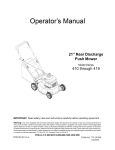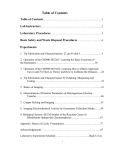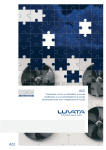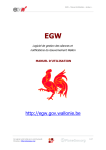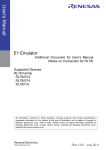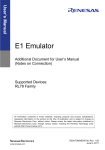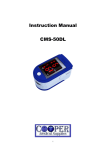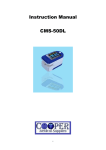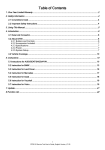Download Operating Instructions Rescue Tools Rescue Sets
Transcript
Operating Instructions Rescue Tools 84150/6133-85 GB Issue 5.96 Rescue Sets with ZPH 1/0,5 HTS 90; LSH - 3 4 1.1 1.4 1.2 2 1.3 2.1 1 2.3 3.3 3 2.2 LSH - 3 3.3 3.2 3.1 1 1.1 1.2 1.3 1.4 Hand pump, Typ ZPH 1/0,5 PN 700 Lever Hand wheel for drainage valve Oil container Oil filling screw 2 2.1 2.2 2.3 Door opener, Typ HT 90 Claw Foot Hydraulik hose DN6 -3000 3 3.1 3.2 3.3 Cutting device, Typ LC 55 Cutting blade, movable Cutting blade, fixed Hydraulik hose DN6 -2000 4 Storage case 1 Basic operation and designated use of the machine 1.1 The machine has been built in accordance with state-of-the-art standards and the recognized safety rules. Nevertheless, its use may constitute a risk to life and limb of the user or of third parties, or cause damage to the machine and to other material property. 1.2 The machine must only be used in technically perfect condition in accordance with its designated use and the instructions set out in the operation manual, and only by safety-conscious persons who are fully aware of the risks involved in operating the machine. Any functional disorders, especially those affecting the safety of the machine/plant, should therefore be rectified immediately! 1.3 The machine is exclusively designed for the use described in the operating manual. Using the machine for purposes other than those mentioned in the manual, such as driving and controlling other pneumatic systems, is considered contrary to its designated use. The manufacturer/supplier cannot be held liable for any damage resulting from such use. The risk of such misuse lies entirely with the user. Operating the machine within the limits of its designated use also involves observing the instructions set out in the operating manual and complying with the inspection and maintenance directives. 2 Organizational measures 2.1 The operating manual must always be at hand at the place of use of the machine! 2.2 In addition to the operating instructions, observe and instruct the user in all other generally applicable legal and other mandatory regulations relevant to accident prevention and environmental protection. This also applies for wearing protective clothing, helmet with visor or goggles and protective gloves. 2.3 In order to avoid innjuries, the machine must only be operated by a specially trained operator who has undergone a safety training. 2.4 Observe all safety instructions and warnings attached to the machine. Make sure that safety instructions and warnings attached to the machine are always complete and perfectly legible. 2.5 Never make any modifications, additions or conversions which might affect safety without the supplier's approval. This also applies to the installation and adjustment of safety devices and valves. 2.6 Spare parts must comply with the technical requirements specified by the manufacturer. Spare parts from original equipment manufacturers can be relied to do so. It is only allowed to use original LUKAS spare parts of LUKAS system components. 2.7 Replace hydraulic hoses at the specified or adequate intervals, even if no defects are detected which might affect safety. This must be done after 10 years, at the latest! 2.8 Adhere to prescribed intervals or those specified in the operating manual for routine checks and inspections. 2.9 Make sure to dispose properly of packing material and dismounted parts! 3 General safety instructions 3.1 In the event of malfunctions, stop the machine immediately and lock it. Have any defects rectified immediately. 3.2 Before starting up or setting the machine in motion and during operation of the machine make sure that nobody is at risk. 3.3 Before transporting the machine always check that the accessories have been safely stowed away. 3.4 Make sure that there is enough lighting during work. 3.5 Avoid any operation that might be a risk to machine stability. 3.6 Check the machine at least after every operation for obvious damage and defects. Report any changes (incl. changes in the machines working behaviour) to the competent organization /person immediately. If necessary, stop the machine immediately and lock it. All lines, hoses and screwed connections have to be checked for leaks and obvious damage. Repair damage immediately. Splashed oil may cause injury and fire. 3.7 All safety equipment has to be checked for completeness and flawless condition: - instruction markings and warning signs (safety instructions) - check safety cover (e.g. motor-safety covers, heat protection etc.) if they are available and if they are in good condition. 3.8 Working under loads is not allowed if they are only lifted by hydraulic cylinders. If the work is indispensable sufficient mechanical supports are needed additionally. 3.9 Do not stress hoses mechanically (pulling, buckling etc.). 4 Instructions for maintenance and service 4.1 For the execution of maintenance and service work, tools and workshop equipment adapted to the task on hand are absolutely indispensable. Work on the hydraulic system must be carried out only by personnel having special knowledge and experience with hydraulic equipment. 4.2 Before putting into operation clean the machine, especially connections and threaded unions, of any traces of oil, fuel or preservatives before carrying out maintenance/repair. Never use aggressive detergents. Use lint-free cleaning rags and pay attention that the components are meticulously clean during reassembling after repair. 4.3 During dismantling of machines it is necessary to collect the outrunning hydraulic liquids completely, so that they cannot reach the ground. They have to be disposed properly according to the instructions. 4.4 Always tighten any screwed and thread connections that have been loosened during maintenance and repair. Observe the stipulated torques. 4.5 Work on the electrical system or equipment may only be carried out by a skilled electrician himself or by specially instructed personnel under the control and supervision of such electri- cian and in accordance with the applicable electrical engineering rules. 4.6 The electrical equipment of machines is to be inspected and checked at regular intervals. Defects such as loose connections or scorched cables must be rectified immediately. 4.7 Aggressive material (acid, lye, solvent, vapour) can damage the machine. It is necessary to clean the whole machine if it must be exceptionally operated under such conditions or gets into touch with these materials. Additionally, the machine must be checked as described under 3.6. 5 Safety Instructions for Hydraulic hoses (HR 1495 35 219) 6 Application 6.1 General 7 Applications The hand pump ZHP 1/0,5 is designed as a two-stage pump which is used for the operation of oil hydraulic single acting cylinders. It is designed for a maximum system pressure of 700 bar. Warning Always check product limitations regarding pressure ratings, load capacities, and set-up requirements. The system operating pressure must not exceed the pressure rating of the lowest rated component in the system. Warning NEVER set the relief valve to a higher pressure than the maximum rated pressure of the pump. Higher settings may result in equipment damage and/or personal injury. The door opener set HTS 90 and cutting device LSH-3 are specially designed for use in the rescue service. 7.1 HTS 90 It is employed, if locked doors have to be opened by force. 7.2 LSH-3 Its operational area is where the requirement is to be able to cut in confined spaces or where access is difficult, e.g. steering-wheel spokes or pedals in vehicles which are severely deformed as a result of an accident. In the industrial and trade field, steel rods, screws, etc. up to 12mm in diameter can be cut. 8 Connecting the pump Door opener HT 90 and cutter LC 55are connected to the hand pump as follows: Remark: the screw couplers SKM 1 and SKN 2 are only properly connected when the sleeve of the female coupler has bees tightened to the last turn. 9 Operation of Hand pump The pump can be used both in horizontal and vertical position, i.e. with the pump head downwards. Check Oil Level Hand pump: approx. 2 cm under the top edge of the oil reservoir. Pumps Make sure that the drain valve is closed (turn lever clock-wise). Return flow of oil will be allowed by opening of drain valve (turn lever anti-clockwise). Transportation The pump lever is used as a carrying handle. 7.3 Venting the Working tool Use the pump to drive out the unloaded piston half way. The pump has to be placed higher than the tool which has to be vented. Now open the drain valve of the pump for retracting the piston by spring retraction. The oil reservoir filler cap must be open. The retracting piston presses the air back into the oil reservoir via the maximum-pressure-hose. The air escapes through the open fillercup. 10 Operating the Working tool 10.1 Door opener HTS 90 10.1.1Points of application: Doors with single protection: locking furniture and hinge plates. Doors with multiple protection: locking furniture, hinge plates and at each locking bolt, if required. 10.2 Cutter set LSH - 3 10.2.1Cutting The knives must be applied in a right angle to the object to be cut. Actuate the pump lever til the work piece is cut through. After the cutting performance open drain valve by turning the lever to the left. The movable cutting blade returns to its initial position. 10.3 Uncoupling pump and Working tool Before uncoupling the pump from the Working tool, make sure (by opening the drain valve) that there is no pressure and that the piston is completely retracted. 10.4 Operating: Safety instructions When operating rescue devices, wear protective clothing helmet with visor or goggles protective gloves. During operation of this rescue device, parts of the object worked on with this device may break away and endanger people standing nearby. Onlookers must be kept at a safety clearance of at least 5m. Prior to using and after repair the pump must be deareated (see 9.1). 10.4.1 Door opener HTS 90 When applying the unit, the claws must be pressed or beaten into the door crack as hard and deep as possible. When working in an environment which involves the risk of explosions, sparks must be avoided when the claws are pushed into the door gap! Attention! There is the risk of sparks, if the device gets in contact with metal or stone! The door opener must be held tight to prevent injuries by the falling device when the door breaks open. Attention! There is the danger of injuries in the area doors breaking open. 10.4.2 Cutter set LSH - 3 Attention! Do not reach in between the cutter arms! Live cables must not be cut apart. Cutting objects under tension (shock absorbers, springs, track rods) is prohibited since cut-off parts of these objects might jerk away unpredictably which exposes the operator and other persons to a high risk of injury. Hardened objects such as spring steel and steering pillars must not be cut. The cutting equipment may only be operated in conjunction with a hand pump, and under no circumstances is it to be driven by a motor pump. The operating pressure must not exceed 700 bar max. 11 Servicing and Maintenance Oil should be changed once a year. In case of frequent use or operation in particularly dusty environment, oil should be changed every six months. 11.1 Adding Oil to the Pump Attention! Always add oil with cylinders fully retracted (extended if pull cylinders) or the system will contain more oil than the reservoir can hold. - Remove vent/fill cap from reservoir. Fill reservoir only to level mark shown on pump. Remove air from system if necessary. See 9.1. Recheck oil level after removing air. Return vent/fill cap to proper position. - Make sure no dirt gets into the oil reservoir or into the pump, as this will cause malfunction. - To extend pump life and improve performance, lubricate the beam pin A, cross pin B and piston head C regulary, using roller bearing grease. See cover page 12 Replacement of Cutting Blades on Cutter LSH-3 Ref. No. of cutting blades: 84150/6400-02. Close drain valve on the hand pump (tighten hand wheel smoothly clockwise) Operate the pump lever until the two cutting blades 1 nearly touch; the fastening bolt 2 of the movable cutting blade is now accessible. Carefully remove the fastening bolt 2 using a hammer and punch. Remove the defective cutting blades 1 and replace with new ones. Hammer the fastening bolt back. Replace defective bolts. Open drain valve again. Note: Deformed or or broken cutting blades must not be resharpened. 13 Troubleshooting Problem Possible Cause Solution Cylinder does Oil level in pump reservoir is low. Add oil according to the Maintenance instructions on 11.1 not advance, advances slowy, Release valve open Close the release valve or advances in Loose hydraulic coupler Check that all couplers are fully tightened spurts. Air trapped in system Cylinder plunger binding Cylinder advances, but does not hold pressure Remove air according to the instructions on page 9.1 Check for damage to cylinder; have cylinder by a authorised dealer or LUKAS themselves Check that all connections are tight and leak free Locate leak(s) and have equipment serviced by authorised dealer or LUKAS themselves Have pump serviced by a authorised dealer or LUKAS themselves Open release valve Leaking connection Leaking seals Internal leakage in pump Cylinder does Release valve closed not retract, retracts part way, Pump reservoir is over-filled or retracts more slowly than Loose hydraulic coupler normal Drain oil level to full mark. See 11.1instructions for adding oil Check that all couplers are fully tightened Air trapped in system Remove air according to the instructions 9.1 Cylinder retraction spring broken Have cylinder serviced by a authorised dealer or LUKAS or other cylinder damage themselves If the defects cannot be repaired, contact an authorised LUKAS dealer or the LUKAS service department. The address: LUKAS Hydraulik GmbH, Weinstraße 39, D-91058 Erlangen, Pf 2560, D-91013 Erlangen, service phone 09131/698 338; fax 09131/698 483 14 Technical data Type ZPH 1/0,5 HR 1494 63181 HR 1494 63181 70 Order no. Working pressure (MPa*) Oil capacity / Usable oil capcity (l) Oil delivery LP / HP (cm³) 0,5 / 0,328 3,62 / 0,9 per piston stroke Automatic switch-over (MPa*) 1,4 Dimensions l x w x h (mm) 340 x 145 x 95 Weight with oil (kg) Type Ref. No. 2,1 HTS 90 84150/6133 *10bar = 1 MPa Type Ref. No. LSH - 3 84150/6466 Spreading force (kN) 90 Cutting force (kN) 54 Stroke (mm) 100 Opening width (mm) 30 Operating pressure (MPa*) 70 Opening depth (mm) 34 Dimensions l x w x h (mm) 410 x 280 x 125 Operating pressure (MPa*) 70 Weight HT 90 (kg) 5,7 Dimensions l x w x h (mm) 410 x 280 x 125 Weight Set (kg) 12,8 Weight of cutter (kg) 2,1 Weight Set (kg) 8,8 14.1 Oil recommendations For LUKAS hydraulic devices, use mineral oil in accordance with DIN 51 524 and others A B C D E Range of oil temperature - 24 ... + 30°C - 18 ... + 50°C - 8 ... + 75°C + 5 ... + 80°C - 8 ... + 70°C Viscosity rating HL 5 HLP 10 HLP 22 HLP 32 HF - E15 Remarks biodegradable Recommended viscosity range: 10 ... 200 mm²/s, delivered with HLP 10 to DIN 51 524 LUKAS Hydraulik GmbH & Co.KG A Unit of IDEX Corporation Weinstraße 39, D-91058 Erlangen Postfach 2560, D-91013 Erlangen Telefon (09131) 698-0 Telefax (09131) 698-394 HTS90LSH3.PM6.5; 5.96 (7.10.99) © Copyright 1997 LUKAS Hydraulik GmbH & Co. KG








